Like many of us I'm attracted to the romantic notion of the cruising life – lazy days aboard a boat built with my own hands cruising New Zealand's coast. Phil Bolger's AS29 has been the dream boat, but it is a massive project, not to be taken on lightly.
So instead, I decided to begin my boat building and sailing career with a much simpler camping sailboat - Jim Michalak's 15ft Philsboat.
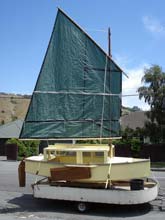 |
Jim Michalak's Philsboat.
click images to enlarge |
I have daysailed it for the last couple of seasons, but what I really wanted to do was an overnight camping trip, specifically to sail from Lyttelton, Christchurch - our local port, to Port Levy the next bay around, an 18 km sail with a short coastal hop of perhaps 1 kilometre around the heads.
| Track for Outbound Leg. |
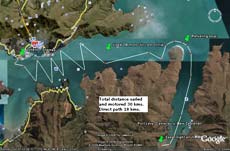 |
..Preparing to Go...
The weather forecast was for settled weather with NE breezes between 10 – 20 knots and a large high pressure zone situated over the country for the next four days. Critically, there were no fronts in the high or nearby, the high tides were timed for early evening and early morning and the swell was about ½ metre offshore. I doubted I could get a better weather outlook. It was now or never!
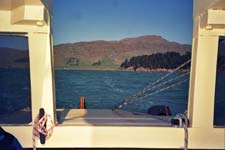 |
Running in 15 knot conditions on Lyttelton Harbour. |
I have come to see that plenty of weight down low in a sailing boat makes for a much more comfortable experience when sailing in rough conditions. The trade off with ballast denser than water, is that if you hole the boat, it goes straight to the bottom, but I think that coastal cruising is all about probabilities – what is more likely, you capsize in rough conditions and cannot right the boat or you hole the boat and sink it. With this in mind, I placed 28 litres of sand and 12 litres of water underneath Philsboat's seats - roughly 43 kgs of ballast. It was only after the trip was over I discovered that sand isn't significantly heavier than water ballast, just an extra 3 kgs in my case, probably because of the air spaces between the sand particles.
..Outbound Leg...
The outbound leg started in 20 knot conditions which moderated to 15 knots late in the day. It was here that I really began to question the concept of sailing as a way of going somewhere without resorting to fossil fuels! The only way out of the harbour was close hauled and my progress to windward was pitiful. I have noticed that in calm water Philsboat's performance is reasonable, but in the rough chop my progress to windward was poor. In an effort to make some headway, I let OUT a reef. The boat ended up with water over it's wales several times, but simply letting the sail out was enough to right it. Paradoxically, sailing Philsboat at high angles of heel, gives you a much better view, since you end up looking out of the slot rather than through the salt sprayed windows!
| A typical 25 knot day on Lyttelton Harbour. You can't see much out of salt sprayed windows. |
 |
After nearly three hours sailing I was only half way to the heads. It became obvious that I would never make my destination by nightfall under sail, so I dropped the rig, fired up the 2hp Yamaha and began bashing away straight into the chop. When sailing close hauled you are between 45 – 60 degrees on to the waves and that heeled flat bottom carves right through them. But going straight into them it's crash, crash, crash! I became concerned that the mast might punch it's way through the bottom of the boat like a pile driver. As luck would have it, the motor ran out of fuel off the heads, giving me a few very anxious moments refilling it as the heads loomed closer with every second. Unlike Michalak's Caroline, Philsboat's stern deck is short enough that you can get at the motor without having to leave the safety of the cabin. However, I'm guessing that Caroline's bow shape would have made a big difference to the pounding problem when under power.
I motored down into Port Levy at dusk with no wind and anchored on the mud flats just a few yards short of the high tide mark in several inches of water. I was so tired, I skipped the evening meal, made up my bed and tried to go to sleep. First the water lapping at the bow kept me awake, then the tide receded leaving me on the mud. Ahh, I thought, now I can get to sleep. But then the wind got up and the halyards started to bang against the mast. The wind died down about 2am only for the nocturnal bird life to begin honking and screeching. Perhaps I snatched an hour's sleep somewhere in there!
 |
On the mud flats at Port Levy. |
..Homeward Leg...
The homeward leg was much more satisfying than the outbound leg. I woke to find the tide was about 100 yards away. I went for a walk for an hour following breakfast and when I returned the water was lapping at the front of the boat. Four inches of water was enough to float that flat bottom and I was able to pull the boat out to water one foot deep, start the motor and depart. Port Levy was very calm and on half throttle I made good progress out to the heads. A light breeze was picking up there and so I motor sailed on quarter throttle on a beam reach to about 1 kilometre offshore to get well away from the heads. Philsboat makes a great motor sailor it seems. Switching off the motor we broad reached along the coastline in a half metre swell to Sumner head. Sailing in a little boat offshore for a significant distance (about 10 kms) is like nothing I've ever done before. The large ocean swells pick you up and drop you down without throwing you about, but the motion brings
on seasickness. Above all you have this feeling of how little you are and how big the ocean is. While I was not in any danger, I was nervous the whole time. My 113 sq ft lug sail was pushing me along at quite a clip. I could see the bow wave coming out in a vee through the tinted windows and I think I was pretty much at hull speed – just under 5 knots.
| Track for Homeward Leg |
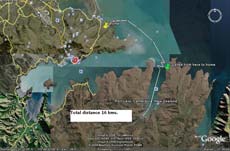 |
At Sumner, the swells were becoming waves at the breakwater. Making the mistake of looking in front of me instead of behind caused an anxious moment when a wave caught me on an angle instead of straight ahead. After that I spent more time looking behind me than ahead, but Philsboat's flat bottom and sharpie bow helped keep things under control before rounding the breakwater to safety.
..Conclusions...
Before taking Philsboat offshore, I made sure the conditions were ideal, had plenty of ballast under the seats and planned the trip to keep time in open water to a minimum. Everybody I've talked to says I was mad to do it and perhaps they are right. There were several times when I thought, I'm totally reliant on this outboard motor. If it doesn't keep going, things could get bad. But I did learn some valuable lessons.
1. In protected waters, sailing around the marks is fine, but in open water sailing to windward is quite unproductive. Now, if this is true then most cruising designs and rigs are optimised for exactly the thing that cruisers never do! A tall Marconi rig on deep keeled boat with fine entry lines is not very good for a cruiser. A low aspect rig on a shallow keel with a fuller bow and finer hind quarters for downwind sailing is better.
2. Being able to anchor out on the mud flats with a flat bottom was great. I know I didn't get much sleep, but I would have got even less, if I had had to anchor in deep water as I would have spent the whole night worrying about the anchor dragging.
3. Being able to lower the mast in a tabernacle would have been a real plus, both when motoring and sleeping at night.
4. While it's good being in a Birdwatcher cabin, because you don't get cold, I would like to be able to see around much more clearly. I also had a fair amount of water splashing into the cabin during the sailing portion of the outbound leg, so that when I came to sleep that night a salty dampness was over everything. I imagine that a cuddy style boat would stay dry inside the cuddy, but then you have the ventilation problem.
..Making Philsboat Coastal Capable...
I'm not talking about blue water sailing, just the ability to coast from bay to bay up to 5 kms offshore in safety and comfort. I don't want to sell my Philsboat and build a Paradox. I'm wondering what modifications would be required. Here's my take on what is needed:
1. A weather-tight cabin. When going any distance in rougher conditions you need to keep the spray out and at night you want to keep the weather out. I'm thinking a permanent ¼ inch hard slot top cover with a sail viewing window near the rear end and swinging hatch/doors front and rear of the permanent hatch. These hatch doors would be mounted on gate gudgeons screwed into timber surrounds of the port front and port rear windows and would swing 180 degrees to overlap the permanent hard slot top cover which has been cut in a curve to match the rotation of the hatch/door. Coamings on the slot cover and hatch/door marry to one another to keep out the water. As the hatch/door can be raised on its gudgeons, it can slip over another coaming on the port side of the slot when closed. Some kind of fastening arrangement can be used to prevent the hatch/door from opening or falling off its gudgeons in a capsize. The hatch/doors must be able to be removed from their gudgeons and stored inside the boat when not wanted.
2. Lots of permanent ballast down low. Need to get hold of some lead, cast it as 10 * 10 kg blocks, embed two bolts in each block and place them five aside under the seats so that the bolts stick through the seat supports into the cabin where nylock nuts can be applied and the ends of the bolts filed off.
3. Mizzen sail. Only needed to keep the boat pointing into the wind when reefing or at anchor. Not desired for sailing. Must be quick to set and remove.
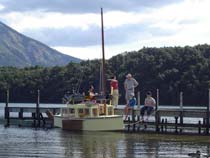 |
The little boat that could! |
..Author...
Rob Kellock
Christchurch
New Zealand
For some video clips of Philsboat sailing on Lyttelton Harbour:
|

